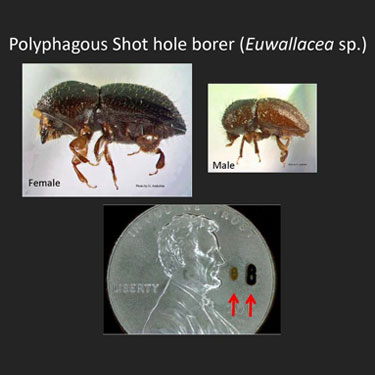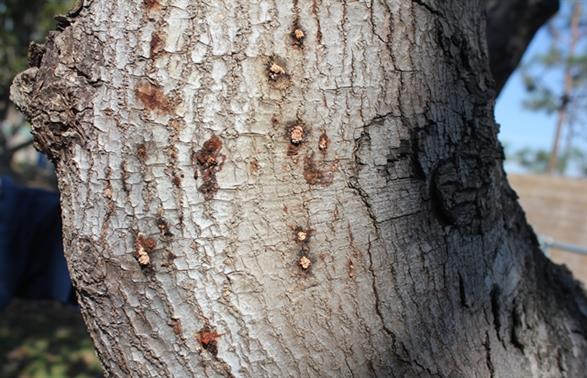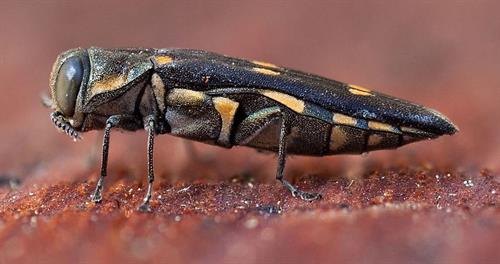Orange County Parks - Shot Hole Borer History
Polyphagous & Kuroshio Shot Hole Borers & Fusarium Dieback
Polyphagous Shot Hole Borer
The polyphagous Shot Hole Borer (PSHB), Euwallacea sp., and Fusarium euwallaceae, a fungus it carries, has been discovered infesting many species of trees in Southern California. PSHB has been found to vector a symbiotic fungus, Fusarium euwallaceae, which has been identified as a species associated with tree dieback symptoms. Both the beetle and fungus are currently rated “Q” by the California Department of Food and Agriculture (CDFA). Together these pests have been found to infest a wide range of hosts, and they present a major threat to the avocado industry in California.
The fungus associated with the beetle causes defoliation and dieback of branches. This damage is due to destruction of the nutrient and water conducting systems of the tree. Injury occurs when the beetle bores into a tree to create tunnels (galleries) for its eggs and larvae and, in the process, inoculates the tunnels with its symbiotic fungi that subsequently clog the surrounding water conducting tissue, or xylem. Exit holes (0.4-1.57 in width) of the beetle along the tree trunk and branches can be identified due to darkened, stained bark, gumming, or white powdery exudates around the holes.


Ornamental and native foliage can fall victim to disease and insect infestation. The increase of these infected plants adds to the overall fire danger risk in Orange County, CA. Infected/infested plants should be removed after they have died.
Goldspotted Oak Borer
An infestation of the Goldspotted Oak Borer (GSOB – Agrilus auroguttatus) has been discovered in approximately 30 oak trees in Orange County as of December 2014. The GSOB is a non-native invasive beetle that has killed an estimated 80,000 oak trees in San Diego County. An infestation of just over 50 trees has also been identified in the community of Idyllwild in Riverside County. Scientists believe that the insect was transported to San Diego County via oak firewood from its native range in southeastern Arizona. The Irvine Ranch Conservancy, OC Parks, the Nature Reserve of Orange County, USDA Forest Service, UC Riverside, UC Cooperative Extension and Orange County Fire Authority are currently working in partnership to identify infected oak trees and develop a pest management plan for the GSOB in Orange County. Because the GSOB reaches adult maturity in May – June, we would like to identify trees that are potentially infested before then so that we can reduce the spread of adult GSOB into healthy trees this summer. You can help in our efforts by not moving firewood out of local areas as this is the primary mechanism for widespread infestation. Please do your part and keep firewood local.
